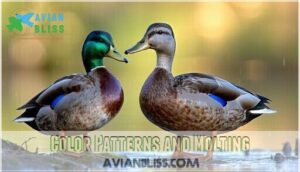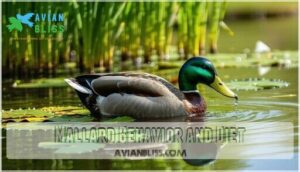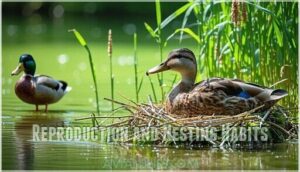This site is supported by our readers. We may earn a commission, at no cost to you, if you purchase through links.
 You’ll recognize mallards instantly—they’re North America’s most common duck. Males sport that famous iridescent green head and bright yellow bill, while females wear mottled brown plumage with orange bills. These adaptable birds thrive in ponds, lakes, and urban parks across the Northern Hemisphere.
You’ll recognize mallards instantly—they’re North America’s most common duck. Males sport that famous iridescent green head and bright yellow bill, while females wear mottled brown plumage with orange bills. These adaptable birds thrive in ponds, lakes, and urban parks across the Northern Hemisphere.
As dabbling ducks, they tip forward to feed on aquatic plants and invertebrates rather than diving underwater. Mallards are social creatures with complex courtship displays and impressive migration abilities, flying up to 21,000 feet.
While populations remain stable, they face challenges from habitat loss and hybridization with domestic ducks. Understanding their seasonal behaviors and preferred habitats reveals fascinating insights about their notable survival strategies.
Table Of Contents
Key Takeaways
- You’ll instantly identify mallards by their distinctive features – males display iridescent green heads with bright yellow bills, while females show mottled brown plumage with orange bills, making them North America’s most recognizable duck species.
- You’ll find these adaptable ducks thriving everywhere from natural wetlands to urban parks across the Northern Hemisphere, as they’ve mastered both wild habitats and city living through flexible feeding and nesting behaviors.
- You’ll observe unique dabbling feeding behavior where mallards tip forward in shallow water to filter aquatic plants and invertebrates through specialized bill structures, rather than diving underwater like other duck species.
- You can support their conservation despite stable populations by protecting wetland habitats, as mallards face ongoing threats from habitat loss, hybridization with domestic ducks, and environmental pressures that affect their genetic diversity.
Mallard Identification and Appearance
You’ll quickly recognize mallards as the most common duck species, with their distinctive size and coloring making identification straightforward even for beginners. These hefty ducks display dramatic differences between males and females, plus they undergo seasonal color changes that can surprise new birdwatchers.
Male Mallard Characteristics
You’ll spot a drake by his stunning iridescent green head plumage that catches sunlight like emerald jewels. The male mallard duck displays a bright yellow bill color and distinctive white collar definition around his neck.
His brown chest shade contrasts beautifully with the white ring around the neck, while his speculum iridescence creates dazzling blue wing patches bordered in white.
Female Mallard Characteristics
Unlike their flashy male counterparts, female mallards sport understated brown plumage with subtle streaking patterns. You’ll notice their orange bills with dark spots—a key identification feature. Their mottled brown coloration provides excellent camouflage during nesting behavior, when they’re sitting on mallard duck eggs. Females are the only ones producing those classic quacking sounds you associate with ducks. Their maternal care instincts drive this practical color pattern design.
Color Patterns and Molting
You’ll notice mallards change their appearance throughout the year through molting cycles. Males develop striking eclipse plumage after breeding, temporarily losing their vibrant green heads for mottled brown feathers that help them hide during flight feather replacement.
- Male Plumage shifts from vibrant breeding colors to camouflaged eclipse plumage in summer
- Female Camouflage remains consistent year-round with mottled brown and buff patterns
- Eclipse Molt occurs twice yearly, affecting flight capabilities and appearance dramatically
- Speculum Iridescence – the blue wing patch – stays visible in both sexes throughout molt cycles
- Hybrid Variation creates unique color patterns when mallards crossbreed with other duck species
Similar Species and Hybrids
You’ll encounter several similar species and hybrid ducks that can complicate mallard identification. Female mallards often get confused with American black ducks, but mallards show brighter orange bills and cream-colored tails.
Hybridization with domestic ducks creates unusual plumage patterns, while interbreeding effects with 40+ species pose genetic concerns. These conservation implications make accurate mallard identification increasingly challenging in urban areas. Genetic research highlights these concerns.
Relative Size Comparison
When you’re out duck watching, mallards sit perfectly between crow size and goose size on the waterfowl scale. These hefty ducks measure 20-26 inches long with a 32-37 inch wingspan, making teal comparison easy since mallards are noticeably larger. Visual guides show their sturdy build and relative size helps distinguish them from smaller dabbling ducks.
Accurate bird identification by size is essential for distinguishing similar species. Understanding mallard measurements and size shape characteristics makes field identification much more reliable than guessing.
Mallard Habitat and Range
You’ll find mallards thriving in nearly every freshwater habitat imaginable, from quiet farm ponds to bustling city parks where they’ve learned that humans often carry breadcrumbs. These adaptable ducks have conquered territories across the Northern Hemisphere and beyond, making them the world’s most widespread waterfowl species.
Freshwater and Wetland Habitats
You’ll find mallards thriving in shallow fresh water environments where aquatic insects and vegetation provide abundant food sources. These adaptable waterfowl prefer ponds, lakes, marshes, and slow-moving rivers with emergent vegetation.
Wetland biodiversity fosters their dabbling lifestyle, though habitat degradation and climate impacts threaten water quality. Effective conservation strategies focus on wetland restoration to preserve essential mallard duck habitat ecosystems.
Urban and Suburban Adaptation
You’ll spot mallards thriving in your neighborhood parks, city ponds, and suburban lakes where they’ve mastered urban living. These adaptable ducks exploit abundant food sources and tolerate close human interaction, creating dense duck populations in urban habitats.
Key urban adaptations include:
- Flexible Feeding Behavior – scavenging breadcrumbs and park handouts alongside natural aquatic plants
- Creative Nesting Sites – building homes in planters, rooftops, and landscaped areas near water features
- Increased Population Density – clustering in prime mallard duck habitats where food and shelter converge
Their adaptive behaviors help them navigate traffic, crowds, and city noise while maintaining their dabbling duck instincts. Supplementing their diet may require specialized duck food.
Migration Patterns
You’ll discover mallards follow four major Flyway Routes across North America during Migration Triggers like temperature drops and shorter days. These ducks prefer Nocturnal Flight, covering impressive distances of 500-800 miles between stopovers.
Climate Impacts increasingly disrupt traditional patterns, forcing habitat adaptations that affect breeding success and duck population stability throughout their conservation range. Protecting these critical stopover sites is essential for their survival.
Geographic Distribution
You’ll find mallards across the globe’s Northern Hemisphere, from North America to Europe and Asia. These adaptable ducks have established themselves on every continent except Antarctica through both natural expansion and human introductions.
Climate change is shifting their traditional flyway mapping patterns, while habitat fragmentation challenges their historic range. Today’s global mallard range extends far beyond their original territories, with introduced populations thriving worldwide.
Mallard Behavior and Diet
You’ll find mallards are fascinating ducks with unique feeding behaviors and complex social lives. These adaptable birds use various techniques to find food and communicate through distinctive calls and displays.
Dabbling and Feeding Habits
Like underwater shoppers at nature’s buffet, you’ll watch mallards employ dabbling techniques to access their varied diet. These dabbling ducks tip forward in shallow water, filtering food through specialized bill structures called lamellae. Understanding this behavior provides insight into their energy replenishment strategies.
- Dabbling techniques: Mallards tip forward to reach submerged vegetation and aquatic insects in water less than 30 cm deep
- Diet composition: Aquatic plants make up 60% of their mallard duck diet, with invertebrates comprising 30% during breeding season
- Seasonal variation: Winter feeding habits shift toward grains and seeds, while spring increases protein-rich invertebrates for egg production
- Foraging locations: They adapt from natural wetlands to urban parks, though food competition remains minimal due to their unique feeding habits
Social Behavior and Courtship Displays
When breeding season arrives, mallards transform into social performers with complex mating rituals. Males compete through dominance hierarchies, showing off with head-bobbing and tail-wagging courtship displays. You’ll see pair bonding develop as females choose mates based on these elaborate breeding behaviors.
Social flocking occurs year-round, but cooperative behavior peaks during successful mating periods when color patterns become most vibrant.
Mallard Sounds and Communication
You’ll notice that mallard vocal repertoire differs dramatically between sexes. Only females produce the classic quacking call that most people associate with ducks, while males can’t quack at all. Instead, male whistles include soft, nasal sounds and drawn-out calls during courtship.
Ducklings communicate through high-pitched peeping to stay close to mom, and all mallards use sharp alarm calls when danger threatens their safety. You can even mimic these sounds with a specialized duck whistle.
Flight and Molting Periods
You’ll notice mallards become flightless during their annual molt when flight feathers drop simultaneously. This flightless period lasts about three weeks while feather regrowth occurs.
Males develop eclipse plumage after breeding, losing their bright colors temporarily.
During migration, mallards reach altitudes up to 21,000 feet, with flight mechanics adapted for long-distance travel covering 800 miles nightly.
Reproduction and Nesting Habits
When spring arrives, you’ll witness mallards’ fascinating courtship rituals as males compete for mates with head-bobbing displays and distinctive calls.
The female then takes charge of the entire nesting process, from selecting the perfect hidden spot to raising her ducklings solo.
Breeding Season and Courtship
The Mallard breeding season kicks off in early spring when hormones surge and courtship displays begin. You’ll witness males performing elaborate courtship rituals, including head-bobbing, tail-wagging, and whistle-like calls to attract females during mate selection.
Successful mating depends on these impressive displays, with dominant males claiming the best territories and partners for ideal reproduction.
Nesting Sites and Construction
Female mallards carefully select nesting spots, often spending a full week scouting locations. You’ll find their nests tucked in tall grass or dense vegetation near water sources.
The dedicated mother constructs her nest using available materials like leaves, reeds, and grasses, creating a cozy bowl. She adds soft down from her own breast during construction, ensuring her future eggs stay warm and protected.
These nests are strategically chosen based on food availability nearby.
Egg Laying and Incubation
Once you’ve spotted a cozy nest tucked away in tall grass, you’ll discover the female’s impressive clutch size of 7-10 eggs with whitish to olive buff coloration. She’ll add soft nest down from her breast during the 26-30 day incubation period, rarely leaving her precious cargo unattended for ideal hatching success.
For those interested in assisting the process, consider using a duck egg incubator.
Duckling Development and Care
After the Hatching Process, young ducklings commence their journey within 24 hours. You’ll observe these notable stages:
- Growth Stages: Ducklings double their weight weekly while developing waterproof feathers
- Duckling Diet: They forage independently but follow mom to prime feeding spots
- Predator Avoidance: Mallard mothers teach socialization skills through protective group formations
Young ducks achieve flight readiness at eight weeks.
Mallard Conservation and Threats
You’ll find that mallards face several conservation challenges despite being one of the world’s most abundant duck species. While their adaptability has helped them thrive globally, habitat loss, pollution, and hybridization with domestic ducks threaten local populations and genetic diversity.
Population Trends and Stability
Across North America, mallard duck populations face mounting pressure from harvest declines and drought impact. The 2025 waterfowl population report shows a 17% drop from long-term averages, with some flyway shifts reducing numbers by over 50%. Urban populations often show hybrid ancestry exceeding 90%, threatening genetic diversity.
Despite conservation efforts targeting habitat loss, duck populations remain nearly half their 2015 levels. However, the latest reports indicate a significant mallard increase.
Habitat Loss and Environmental Threats
Multiple threats endanger mallard populations despite their adaptability. Wetland destruction removes critical nesting areas, while lead poisoning from ingested shot pellets kills thousands annually. Climate change alters migration timing, and oil contamination at energy facilities creates deadly traps you mightn’t expect.
- Wetland Destruction: Over half of North America’s wetlands have vanished, leaving ducklings without safe nurseries
- Lead Poisoning: Spent ammunition continues killing mallards decades after being banned in many areas
- Pesticide Impact: Neonicotinoid pesticides weaken immune systems, making birds vulnerable to disease outbreaks
- Oil Contamination: Unregulated energy facilities create toxic death traps during migration stopovers
- Habitat Loss: Urban sprawl fragments breeding grounds, forcing mothers to lead ducklings across dangerous terrain
Hybridization and Genetic Impact
When mallards breed with domestic ducks, you’ll see genetic consequences that threaten native species like the American Black Duck and Mottled Ducks. This hybridization creates hybrid ducks with altered traits, challenging conservation efforts.
Domestic duck influence spreads through generations, causing evolutionary implications that reduce genetic purity. While hybrid vigor might seem beneficial, the hybridization threat undermines wild populations’ unique adaptations.
Conservation Efforts and Wetland Restoration
You can help protect mallards through Wetland Creation projects and Habitat Preservation efforts. Conservation programs have restored over 15 million acres, showing 300% increases in mallard broods at restored sites.
Community Involvement in Duck Conservation includes removing drainage systems and controlling invasive species. These efforts build Climate Resilience against habitat loss while reducing Pollution Reduction threats to wetlands.
Role in Ecosystem and Human Interaction
Beyond their beauty, mallards serve as Ecosystem Engineers, reshaping wetland environments through seed dispersal and nutrient cycling. You’ll notice Urban Mallards adapting remarkably to city life, though this creates a Conservation Paradox. Their success masks serious threats:
- Hybridization Effects threaten native species like Hawaiian ducks
- Human Impact includes habitat loss and pollution from development
- Duck Conservation efforts must balance abundant mallards with Endangered Species protection
Frequently Asked Questions (FAQs)
Is mallard only a male duck?
No, "mallard" refers to the entire duck species. You’ll find both male and female mallards, with males sporting distinctive green heads and females displaying brown, mottled plumage patterns.
What’s the difference between a duck and a mallard?
A duck is the general term for waterfowl, while mallards are a specific duck species. Mallards are the most common duck worldwide, recognizable by males’ green heads and females’ brown plumage.
Is a mallard a good pet?
Mallards aren’t domesticated birds and keeping them as pets is usually illegal without special permits. They’re wild waterfowl requiring specialized care, large water sources, and space to fly—they’ll never truly adapt to captivity like you’d hope.
What does mallard mean?
Mallard" refers to a large dabbling duck species with distinctive green heads (males) and brown plumage (females). You’ll recognize them as the most common wild duck, found on ponds and lakes worldwide.
Do mallards migrate?
Like feathered nomads crossing vast continents, you’ll find these ducks aren’t homebodies. Some mallards migrate hundreds of miles seasonally, while others stay put year-round depending on climate and food availability.
How do mallards sleep?
You’ll spot mallards sleeping with one eye open and half their brain awake – it’s called unihemispheric slow-wave sleep. They usually rest on water or land, tucking their bills under wing feathers while staying alert for predators.
How long do mallards live?
Duration determines destiny for ducks – you’ll find mallards usually live 5-10 years in the wild, though some reach 20+ years. Predation, disease, and hunting substantially impact their lifespan in natural settings.
Are mallards ever dangerous?
You usually don’t have to worry—these ducks won’t attack unless you mess with their nest or ducklings. **If you get too close, expect a lot of hissing, wing-flapping, and maybe a peck, but nothing serious.
How do mallards mate?
Elegant courtship displays contrast with the harsh realities of mallard reproduction. During the spring mating season, you’ll observe males bobbing heads, performing ritualized preening, and chasing females.
These behaviors culminate in copulation occurring on water, highlighting the intricate balance between beauty and survival in nature.
How long do mallards typically live?
You’ll find mallards live around 5-10 years in the wild, though some lucky ducks reach 20+ years. Predators, disease, and hunting keep most lifespans shorter than their potential maximum.
Conclusion
Like ancient mariners reading the stars, you’ve learned to recognize the mallard’s distinctive features across seasons and habitats. These resilient ducks prove that adaptation wins over specialization, thriving in everything from untouched wetlands to city ponds.
By supporting wetland conservation and understanding their complex behaviors, you’re helping protect North America’s most familiar waterfowl. The mallard’s success story reminds us that some species can flourish alongside human development when we create the right conditions for coexistence.
- https://en.wikipedia.org/wiki/Mallard
- https://thefarmatwalnutcreek.com/animal/mallard-duck/
- https://www.birdrescue.org/conservation-education/education/meet-the-birds/mallard/
- https://www.pa.gov/agencies/pgc/wildlife/discover-pa-wildlife/mallard-ducks.html
- https://pubs.usgs.gov/unnumbered/5230110/report.pdf













